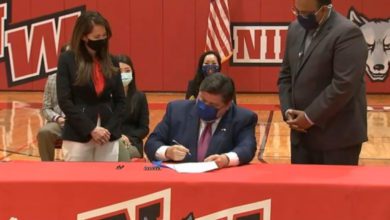Mahomet-Seymour ready to open doors for 2021-22 school year

Monday night’s Mahomet-Seymour School Board meeting may have been an indication of what’s to come as students return to school on Aug. 18.
With less than 36 hours until the first bell rings, emotions ran high and the uncertainty that has plagued school-aged parents for 18 months was still present.
Superintendent Lindsey Hall said there was not anything to update the board of education on under the COVID-19 agenda item. She stated that information had either gone out to parents, is in the School Reopening Plan or would be discussed with the teaching staff on Tuesday.
Still, a few board members had questions and constituents stood before the board at the end of the meeting to share their thoughts on masking at school.
Similar scenes are being reported all over the United States.
Between the release of the board agenda on Thursday afternoon and Monday’s meeting, public comment had been moved from the beginning of the meeting to the end of the meeting. Board president Max McComb sent an email to district parents Monday morning, changing the time limit for each speaker from five to three minutes, and capping each topic off at 20 minutes.
Although board policy states a minimum of 30 minutes is set for public comment, McComb wrote that a 30-minute maximum limit would be “honored.”
McComb also addressed the mask mandate in his email.
“While we certainly wish that the circumstances were different, masks are mandated for all staff, students and visitors while inside our school buildings. This requirement from Governor Pritzker went into effect upon the issuance of Executive Order 2021-18 on August 4, 2021.
“The law which Governor Pritzker cites in his August 4, 2021 Executive Order 18 requiring universal K-12 masking is the Illinois Constitution and a number of provisions of the Illinois Emergency Management Agency Act, 20 ILCS 3305. Once the Governor has issued a disaster declaration as provided for in the Act, he may exercise emergency powers identified in Section 7 of the Act, which include in Section 7(8) control of “the occupancy of premises” within the disaster area and in Section 7(12) the “exercise of any other functions, powers, and duties as may be necessary to promote and secure the safety and protection of the civilian population.” The Governor then exercises these powers through executive orders, such as Executive Order 18, which in effect also become the law.
“As a result of this change, we completely understand that many parents and community members are frustrated, angry and upset with a mask mandate. We’ve heard you and are listening. However, it is important to understand, and legal experts with affiliated schools and not affiliated with schools concur that Boards of Education cannot change this mask mandate. Our own Senator Chapin Rose holds this opinion. Additionally, Boards of Education who choose to violate the mask mandate face serious legal risks as well as follow up from the Illinois State Board of Education that will adversely impact our school district, our students and our community.”
Almost all of the public voices at the school board advocated that the board stand up to Pritzker to contest the mandate. One junior high school declared that he would no longer do what he is asked to if it violates his free will and goes against his beliefs.
Despite local pressure, the Mahomet-Seymour School Reopening plan follows state mandates, requiring universal masking for all staff, students and visitors inside school buildings, at indoor athletic activities and on the school bus.
“The simple act of wearing a mask at all times while inside all buildings will allow us
to employ the strategies listed above, and ensure that students are able to stay in
school and enjoy extracurricular activities,” the plan states.
Mahomet-Seymour will also follow IDPH guidelines in using 3-feet distance for contact tracing, and implementing a test-to-stay approach, which allows students to stay on campus if they were exposed at school while two individuals were wearing masks if they subject to testing on days 1, 3, 5 and 7 after exposure.
Board member Meghan Hennesy asked about the district’s approach to testing, asking if the district would take advantage of the free SHIELD testing that some other districts will implement.
Hall said that Mahomet-Seymour would continue to use Abbott’s BinaxNOW COVID-19 test, which gives results in 15 minutes. Hall said the district had a few false positives, but Hennesy said it’s the false-negatives that need to be of concern.
According to the CDC, “Sensitivity (the ability of the test to identify people with antibodies to SARS-CoV-2) of the BinaxNOW antigen test, compared with polymerase chain reaction (PCR) testing, was lower when used to test specimens from asymptomatic (35.8%) than from symptomatic (64.2%) persons, but specificity (the ability of the test to correctly identify people without antibodies to SARS-CoV-2) was high. Sensitivity was higher for culture-positive specimens (92.6% and 78.6% for those from symptomatic and asymptomatic persons, respectively); however, some antigen test-negative specimens had culturable virus.”
With results that come back in about 15-minutes, the Mahomet-Seymour School District believes this is the best first-line of defense against COVID-19 spread.
Hennesy suggested through that SHIELD testing, that the SHIELD test that has a 97-percent sensitivity rate and a 99-percent specificity rate was more accurate.
The Illinois State Board of Education wrote, “This level of accuracy means that staff or students who test positive don’t need to seek a second test result to confirm the result. Consistent use of this test has kept the COVID-19 positivity rate below 1 percent at the University of Illinois Urbana-Champaign and is already being used at several districts across Illinois,” in their COVID-19 Testing FAQ.
Hall said those results take 24 to 48 hours to come back.
Board member Ken Keefe suggested that the district administer both tests, but Hall said the district did not have enough resources to accomplish that task.
A June 30, 2021 report published in the The Journal of Infectious Diseases concluded that PCR tests are more effective than antigen tests at identifying infected individuals prior to or early during the infectious period.
Results also indicated “98% sensitivity for identifying infected individuals if used at least every 3 days. Daily screening using antigen tests can achieve approximately 90% sensitivity for identifying infected individuals while they are viral culture positive.”
“This work also shows how the PCR and antigen tests could be used in combination,” Rebecca Lee Smith, a professor of epidemiology at the University of Illinois told the Illinois News Bureau. “For example, I work with a lot of school districts, helping them to plan for fall, since vaccines are not yet available to those under 12 years old. If a student had a known exposure or comes to school symptomatic, give them both tests. Antigen tests are really good at finding those highly infectious people, so that they can tell administrators right away if the child needs to be sent home, rather than waiting 24 hours for PCR results. If the antigen test is negative, the PCR test is a backup, as it may detect the infection earlier than an antigen test would, before the student becomes contagious.”
The FDA suggests that when an individual receives a negative antigen test, the exposure and symptoms should continue to be taken into consideration.
Hennesy said her suggestion was just another way to keep kids in school when districts are reporting large numbers of students being quarantined after exposure to outbreaks in schools.
Board member Colleen Schultz asked about the district’s quarantine procedures. Hall said general information could be found in the School Reopening Plan and detailed information is in the Health Plan located on the website.
Hennesy also asked about an e-learning plan should the district be instructed to return to remote learning. Hall said that the district has weather-related e-learning plans in place, but that those would only be a temporary solution.
She recognized what is happening in other states, calling it “discouraging”. Hall said that she would meet with teachers Tuesday to discuss plans with them and a report would come to the board for the Sept. 13 meeting.
Prince-Guerra JL, Almendares O, Nolen LD, et al. Evaluation of Abbott BinaxNOW Rapid Antigen Test for SARS-CoV-2 Infection at Two Community-Based Testing Sites — Pima County, Arizona, November 3–17, 2020. MMWR Morb Mortal Wkly Rep 2021;70:100–105. DOI: http://dx.doi.org/10.15585/mmwr.mm7003e3external icon
University of Illinois System. (2021). Shield Illinois saliva test. University of Illinois System. https://www.uillinois.edu/shield.
Rebecca L Smith, Laura L Gibson, Pamela P Martinez, Ruian Ke, Agha Mirza, Madison Conte, Nicholas Gallagher, Abigail Conte, Leyi Wang, Richard Fredrickson, Darci C Edmonson, Melinda E Baughman, Karen K Chiu, Hannah Choi, Tor W Jensen, Kevin R Scardina, Shannon Bradley, Stacy L Gloss, Crystal Reinhart, Jagadeesh Yedetore, Alyssa N Owens, John Broach, Bruce Barton, Peter Lazar, Darcy Henness, Todd Young, Alastair Dunnett, Matthew L Robinson, Heba H Mostafa, Andrew Pekosz, Yukari C Manabe, William J Heetderks, David D McManus, Christopher B Brooke, Longitudinal Assessment of Diagnostic Test Performance Over the Course of Acute SARS-CoV-2 Infection, The Journal of Infectious Diseases, 2021;, jiab337, https://doi.org/10.1093/infdis/jiab337
Touchstone, L. A. (2021, June 30). Frequent COVID-19 testing key to EFFICIENT, early detection, study finds. ILLINOIS. https://news.illinois.edu/view/6367/692215684?fbclid=IwAR14WxN-R8hpC-xBQXfqeHz3jZteESjx2xiwp-Cs62d-txU3sMet2cKLCWk.




